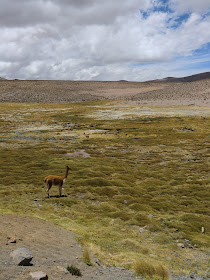Bolivian trucks entering Chile
Today, I'm taking a day trip up to Lake Chungara in Parque Nacional Lauca, near the Bolivian border. The majestic lake is surrounded by snow capped volcanoes. I'm excited.
We ride in a medium sized Marcopolo bus. I've seen the "Marcopolo" emblem on dozens of different kinds of buses in Peru and Chile. I thought it was a descriptor, like cabriolet, but a local informed me it is actually the name of a large Brazilian bus manufacturer. Who knew.
Anyway, our bus was comprised of Brazilian and Chilean tourists, and me. Everyone came as a couple, except me. Oh well.
One last thing before we start. We're going to be traveling up to 4,500 meters (15,000 feet). Some buses come with oxygen tanks for sick passengers. Ours doesn't. Oh well.
The journey starts in Arica at sea level. Our first stop is the Lluta Valley Geoglyphs. It's no Nazca Lines, but still sort of interesting.
Here is the 17th century San Geronimo Church in Poconchile:
We are still in the valley but the elevation is quickly rising.
We came across these odd candleholder cacti, which grow just 5 mm a year. They get their water by absorbing the moisture in the clouds and fog.
Trust me, the needles hurt.
We stop early for lunch at a truck stop. They asked me if I wanted coffee or tea. I said tea. This is what I got.
Yup, coca leaf tea. I've already taken my altitude medication, but I drank the tea anyway. When in Rome,.... By the way, a physician friend and a pharmacist friend both assured me that coca and Diamox do not contraindicate each other.
The coca tea tastes like diluted Japanese green tea. I can't tell if it helps with altitude sickness because I already took the Diamox. But it did give me a boost of energy.
A word about American excess. While dining, I noticed how thin and small the paper napkins were. But they did the job. In America, some paper napkins are so thick, they feel like cloth. After lunch, I used the men's facilities. The porcelain urinal was shaped like half a coconut and would barely be able to fit a bowling ball. But it did its job (let's face it, no matter how big a urinal is, men will still miss). American urinals, by mass, are probably ten times larger.
Why do I mention this? We in the West consume way too much in resources. Just think of all the extra trees we could save if we had thinner and smaller napkins. Or how much fuel we'd save by manufacturing lighter urinals. Is our standard of living that much better with bigger things?
But I digress. While everyone else is in the warm dining hall, I decide to take a stroll around the parking lot. Coming up from Arica, I noticed a lot of 18-wheelers with Bolivian plates. Because Bolivia is landlocked, it has to use ports in Chile and Peru. That goes a long way in explaining why Bolivia is one of the poorest countries in Latin America. I saw a group of men around a parked truck, so I thought I'd see what they were up to.
Here are the guys. I've managed to take a picture and obscure four of the five guys. But if you look closely, you can see all of them. After some quick salutations in Spanish, these guys went back to speaking some indigenous language. The guy on top has diesel in that container, and that's about as much information as I could gather.
Just before the national park is the small town of Putre.
This mural is in the town center, and that writing ain't Spanish.
Almost everyone has a cell phone so this public phone is obsolete.
Altiplano is one of those cool geographical words you learn in grade school, along with steppe. The scenery is out of this world. The two little dots in the middle of the picture below are two huge condors.
Vicunas!
We are approaching the grand lake.
Here is the lake!
This road, which is in perfect condition, leads to the Bolivian border, which is just a few more kilometers away.
This is as far as we go today. We will start heading back in the bus right after that solo traveler takes another picture and feels the grass.
The grass in the foreground feels like astroturf.
As we descend, an elderly lady and a ten year old boy on our bus are really ill. I wasn't so worried about the boy, but the woman did not look okay. Fortunately, after about four hours retracing our steps and returning to Arica, she seemed better.
The Diamox and coca leaves were partially effective. At the lake, I still had a headache. What was more disconcerting was that the lower half of my face felt numb and tingly. Yikes.






















This grass on last photo looks like moss... :)
ReplyDeleteI've heard a rule of thumb that for every 3000ft of altitude an engine loses 10% of it's power capability. So at 15k ft these buses are only making half power compared to sea level? I wonder how they can make it up the mountain. Are they turbocharged?
ReplyDelete@JJ: That was the cool thing about the flora. Almost everything down there is familiar, yet very foreign. The plant life gets really whacky down in Tierra del Fuego.
ReplyDelete@midelectric: Good point. If you haven't seen the Top Gear episode where they go from Bolivia to Chile, you should watch it. It covers much of what I did (except the jungle and the death road). They were much higher and their cars were choking to death. I didn't notice if our bus was turbocharged, but it wasn't exactly wheezing or sluggish either. Now I wished I had paid more attention.
Another excellent read. Thanks for sharing Kashgar.
ReplyDelete